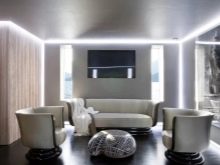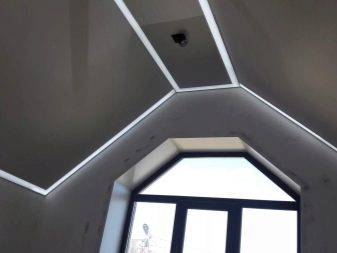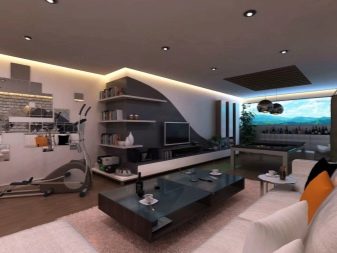Illuminated ceiling around the perimeter
The ceiling with illumination around the perimeter is one of the types of design lighting options for the room, which serves not as the main, but as an auxiliary light source. With the help of this lighting with a plinth you can do with your own hands a fabulous and mysterious hue to the room.
Special features
To use the contour lighting of the ceiling can be in rooms with both low and high ceilings. In the first case, the lighting around the perimeter will help to visually expand the narrowness of the room and create a “soaring ceiling effect”.
Also, such lighting looks stylish and attractive, it is used throughout the expensive designer repairs, giving the room a sense of luxury and modernity.
Kinds
The classification of the contour lighting can be carried out according to several criteria: according to the placement of the light source when using a niche box and according to the type of lighting devices.
Depending on the location of the lamps, as well as the possible presence of a fence in the path of the direct propagation of light varies the width and brightness of the contour strip around the perimeter of the room and the lighting in general.
- Moderate band of light. The lamp is located luminous element to the center of the room, the direct distribution of light is blocked by the side wall of the box. However, the lighting device is located near the wall at a high level and only part of the rays are refracted, the width of the contour strip is 150-300 mm.
- Bright line of light. The location of the lamp is towards the center, direct propagation is blocked, the device is located at a low level, all the light is refracted about the box into a thin bright band around the perimeter of the room, the width of the backlight is 100-200 mm.
- Very bright streak of light. The lamp is located by the luminous element to the wall and is located near the side wall of the box, while the light is reflected from the wall on the ceiling plane into a narrow and very bright strip 50-100 mm wide.
- Broken streak of light. The lamp is turned by the luminous element to the center of the room, the side wall of the box is absent, and the light propagates freely, creating a band of light of 300-500 mm.around the perimeter of the room.
Depending on the technology of production of lamps, both the specifics of the lighting itself and the operational features of the backlight change. There are such common types:
- fluorescent;
- neon;
- LED.
Fluorescent lighting
One of the classic types of lighting, light is created by an electrical discharge in a gaseous environment. The low temperature of operation of such devices allows them to be used with various finishing materials without the possibility of damage. The positive features include:
- high luminous efficiency, the ratio of consumed power (in watts) to radiated (in lumens) from 50 to 100 times;
- long service life guaranteed by the manufacturer;
- low working temperature, this indicator does not exceed 60 С;
- several shades of lighting:
- warm daylight;
- daylight;
- cold daylight.
- lack of stroboscopic effect (flicker).
The weak sides of fluorescent lamps include:
- relatively high cost;
- service life depends on the number of on / off and decreases with frequent switching;
- not recommended for patients with epilepsy and skin diseases;
- unregulated brightness of lighting;
- relatively large size complicates the replacement process, especially with closed structures with small gaps for light;
- inside the lamp contains toxic mercury, in case of leakage (for example, when broken), prolonged ventilation of the room is necessary and wet cleaning with manganese is desirable.
Disposal requires special care because of the mercury content in the lamp.
Neon lighting
They are used only as auxiliary light sources due to the low radiation intensity. Neon light has a distinctive visual specificity, characteristic only for him: it seems that it is blurred, like evaporation of water in the heat. Also, when illuminated by neon, no sharp shadows are formed. The positive qualities of such lamps include:
- a wide selection of colors emitted light;
- the intensity and color of the lighting can be controlled by the control drivers;
- volumetric radiation that does not create shaded areas;
- the angle of illumination of the neon tube is 360 degrees;
- very long service life on condition of quality production - up to 15 years;
- the operating temperature of the device does not exceed 50 degrees;
- The form of execution of light tubes can be practically any, which increases the design possibilities of such lighting.
The negative aspects when using neon lighting include the following factors:
- energy consumption is more economical than that of incandescent lamps, however, this indicator is three times higher than for LED analogues;
- Often, neon devices contain toxic components (eg, mercury), which makes their use dangerous and requires special care when handling;
- Recycling requires special measures due to the content of toxic substances, you can not just throw waste lamps in the trash;
- structural fragility;
- require professional installation in order to avoid various complications (for example, arc lightning, to avoid leakage).
The low intensity of the luminous flux determines the secondary nature of such lighting, the room will have to install the main light source for full use of the room (for example, reading or small handicrafts).
LED lightening
This technology is the most optimal by most indicators. LED lamps have a unique performance characteristics of a different plan: power consumption, size, service life and others. The characteristic features of these lamps include:
- the maximum coefficient of light output, the lamp emits in lumens 110 times more than consumes in watts;
- huge warranty period of service up to 100 thousand hours;
- lighting intensity is adjustable with the help of drivers; lamps are resistant to power surges;
- temperature range of working medium from -60 to + 60 С;
- instant operation at full capacity;
- compact size combined with durable polycarbonate glass make the LEDs extremely resistant to mechanical stress, vibration and water penetration to the level of IP68;
- a wide choice of radiation spectrum from warm yellow to cool white;
- the absence of any sounds when operating the device;
- low-voltage current is required for operation, so even if the case is destroyed, exposed elements do not endanger life;
- low working temperature of the radiating element;
- do not contain hazardous components;
- they do not emit in the harmful spectrum, there is no flickering and stroboscopic effect (except for cheap low-quality products).
LED lighting also has its negative sides, but there are not very many of them:
- such lamps are more expensive than other types of products, but low power consumption and an enormous service life over time correct this minus a big plus;
- There are results of studies according to which the light of these lamps stimulates the production of serotonin, which is responsible for vigor and efficiency, which may be inappropriate in the evening before bedtime.
Next, see a review of the stretch ceiling with lighting around the perimeter.























































